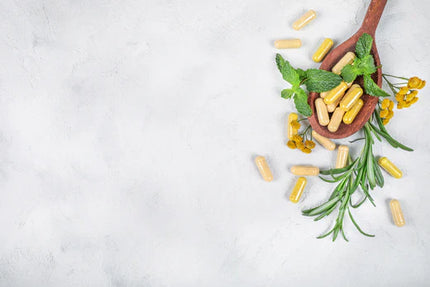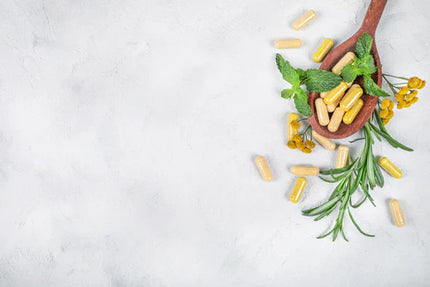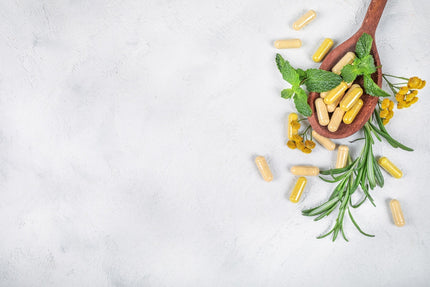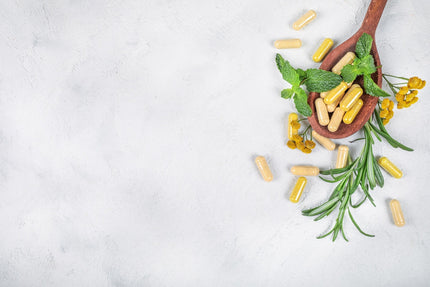Probiotic Strains That May Assist
Lactobacillus rhamnosus (LGG®)
Saccharomyces cerevisiae (boulardii)
Bifidobacterium animalis ssp lactis (BB-12®)
Clinical Actions and Applications
- Supports intestinal microbiota restoration
- Displaces opportunistic pathogens
- Supports healthy gastrointestinal function
- Protects intestinal barrier integrity
Strain Specific Probiotics for Gut Microbiota Restoration and Support
The gastrointestinal tract (GIT) is home to a dense community of microorganisms that play a crucial role in digestive function and maintaining balance within the body. Recent advancements in evaluation methods have significantly expanded our understanding of key microbial groups and their importance to human health. These methods have also highlighted various factors that can influence the composition and function of healthy microbiota.
With this new knowledge, our understanding of how probiotic organisms like Lactobacillus rhamnosus (LGG®), Saccharomyces cerevisiae (boulardii) (SB), and Bifidobacterium animalis ssp lactis (BB-12®) interact with both beneficial and potentially harmful bacteria has grown. These well-researched and impactful probiotics have demonstrated their ability to protect beneficial bacterial groups, restore gut microbiota in imbalanced conditions, displace harmful pathogens, strengthen the gut lining, and improve overall gastrointestinal function.
Background Technical Information
The Human Microbiome
The human gastrointestinal tract (GIT) hosts a diverse community of microorganisms from all three domains of life: Archaea, Bacteria, and Eukarya.[1] Recent estimates suggest that 38 trillion bacteria live in the human body, particularly in the lower intestine. This number is roughly equal to the number of human cells.[2]
Over the past decade, molecular profiling techniques have greatly enhanced our understanding of the intestinal microbiome. These techniques, applied across various populations and geographical locations, have provided deeper insights into key bacterial genera and their importance for gastrointestinal health and function.[3]
Bacterial composition varies among individuals and populations. Some research suggests the existence of defined microbiome “enterotypes,” indicating an individual’s bacterial balance “set point.” [4] While this concept is still emerging, there is some consistency in identifying specific bacterial groups indicative of a healthy gut microbiota.[5] At the phylum level, these groups are dominated by Firmicutes and Bacteroidetes, with Actinobacteria, Proteobacteria, and Verrucomicrobia also represented. Important genera within the Firmicutes phylum include Faecalibacterium, Eubacterium, Clostridium, Blautia, Ruminococcus, and Roseburia. These genera are considered the “core gut bacteria” shared globally.[6]

Figure 1: LGG® and SB Rebuild Core, Native Commensal Bacteria.
Research confirms that these core bacterial groups can be disrupted by various factors, leading to an imbalance known as dysbiosis.[7] Dysbiosis can result from antibiotic use, stress, lifestyle factors, and variations in GIT transit time, such as diarrhea or constipation. It is also linked to various diseases.[8] Strain-specific probiotics, LGG®, SB and BB-12® may help prevent disruption of these core bacterial groups and aid in restoring healthy bacteria when imbalances occur (Figure 1).
Clinical Actions and Applications
Supports intestinal microbiota restoration
The intestinal microbiota play a crucial role in maintaining human physiological homeostasis. Their functions include[8]:
- Producing short-chain fatty acids (SCFAs), such asbutyrate
- Producing secondary metabolites and vitamins
- Processing and salvaging nutrients and drugs
- Enhancing immune system awareness
- Influencing metabolism, including glucose and lipid metabolism
- Recycling water and electrolytes from intestinal contents
These functions highlight how microbiota and their modulation affect various disease states and contribute to overall health. Specific probiotic strains can influence gastrointestinal microbiota and clinical outcomes.[9]
Table 1 shows key human clinical studies on the modulatory effects of Saccharomyces cerevisiae (boulardii) (SB), Lactobacillus rhamnosus (LGG®), and Bifidobacterium animalis ssp lactis (BB-12®). Antibiotic trials are particularly useful for studying microbiota disruption,[10] causing both acute and chronic changes in microbiota quantity and diversity lasting up to four years.[11] Key butyrate-producing species like Faecalibacterium prausnitzii are especially vulnerable to antibiotics, [12] with their depletion linked to gastrointestinal diseases.[13]
Supporting core commensals, SB, LGG®, and BB-12® can promoting a healthy gut microbiome, with numerous studies support these findings, replicating the beneficial effects on microbiota. [14,15]
Table 1: SB, LGG® and BB-12® protects the intestinal microbiome
|
Population studied |
Treatment |
Effect on microbiota by probiotic |
|
Antibiotic therapy for bacterial vaginosis (n=60) [12] |
15 billion CFU SB daily; 2 weeks |
Preserved and protected key bacterial groups; Bacteroides, Roseburia & Faecalibacterium and preventive increase of opportunistic groups. |
|
Antibiotic therapy in healthy individuals (n=48)[16] |
30 billion CFU SB daily; 2 weeks |
SB therapy attenuated the impacts of antibiotics on key commensals. |
|
Chronic idiopathic diarrhoea in otherwise healthy individuals (n=20)[17] |
10 billion CFU SB daily; 3 weeks |
SB therapy supported restoration of commensal bacterial groups, Roseburia and Bacteroides correlated with improvement in diarrhoea. |
|
Healthy elderly individuals (n=12) [18] |
20 billion CFU LGG® daily; 28 days |
Bifidobacterium and the dominant butyrate producers Roseburia and Eubacterium increased, with improved SCFA production. |
|
Children with cystic fibrosis (n=22) [19] |
6 billion CFU LGG® daily; 3 weeks |
Significant increase in Bacteroides genus and trends in Faecalibacterium increase, resulting in partial microbiota restoration. |
|
Antibiotic therapy for Helicobacter pylori eradication (n=804) [20] |
20 billion total LGG® and BB-12® CFU daily; 2 weeks |
Increased H. pylori eradication compared to placebo, along with significant benefits in gastric symptoms. |
Displacement of Opportunistic Pathogens
During dysbiosis, key commensal species are displaced, making the gastrointestinal environment more susceptible to colonization by potential pathogens such as Escherichia, Salmonella, Clostridium, and Enterococcus.[21,22] Probiotics can act as temporary guardians, preventing pathogenic adherence and supporting the resettlement of commensal bacteria.[8]
Mechanistically, probiotics work in several ways[10,23-26]:
- Direct Antimicrobial Action: Probiotics produce antimicrobial peptides like bacteriocins.
- pH Reduction: They lower gut pH through SCFA production, disrupting pathogenic activity.
- Immune Enhancement: Probiotics boost the host’s immune response via dendritic cell modulation and secretory IgA stimulation, improving pathogen detection and elimination.
The pathogen-displacing properties of Saccharomyces boulardii (SB) have been demonstrated in children with Blastocystis hominis infection. In a study with three treatment arms (SB intervention, metronidazole, and placebo), SB was as effective as the antibiotic in eradicating B. hominis. SB’s clinical efficacy in antibiotic-associated diarrhea (AAD) [27] and travelers’ diarrhea is partly due to this pathogen displacement mechanism.[21,28]
Lactobacillus rhamnosus (LGG®) and Bifidobacterium animalis subsp. lactis (BB-12®) also exhibit pathogen-displacing properties. In a large multicenter trial, combining LGG® and BB-12® with Helicobacter pylori antibiotic therapy resulted in more effective eradication than antibiotics alone.[20] An in vitro study showed that pairing LGG® and BB-12® enhances their adhesion
LGG® supplementation not only modulates specific bacterial groups but also reduces enzymes like β-glucuronidase, a marker of gut microbiota balance. Increased β-glucuronidase activity indicates an imbalance in gut microbiota.[29]
Supports healthy gastrointestinal function
Acetate, propionate, and butyrate are the primary SCFAs produced during colonic fermentation.[30] SCFAs disrupt GIT pathogens and support important gastrointestinal functions. Butyrate, produced by many Firmicutes genera, is absorbed by colonic epithelial cells and oxidized into ketone bodies for ATP synthesis.[31] This SCFA is crucial for cellular homeostasis, exhibiting anti-inflammatory, antioxidant, and anticarcinogenic properties.[32]
Probiotics enhance butyrate and SCFA production through[8,18,30]:
- Direct creation of acetate via substrate fermentation (e.g., Bifidobacterium).
- Supporting bacterial cross-feeding by producing lactate and other substrates (e.g., Bifidobacterium and Lactobacillus).
- Enhancing gene expression for key butyrate producers (e.g., Roseburia and Eubacterium) with LGG®.
- Disrupting pathogens that hinder SCFA-producing commensal groups.
SCFA depletion has been observed in patients with mixed refractory constipation. SCFAs regulate colonic motility by stimulating 5-HT release and upregulating ChAT-expressing neurons, resulting in a prokinetic effect. This mechanism may explain the clinical benefits of BB-12® supplementation in constipated patients. In a large clinical trial (n=1248), BB-12® significantly increased defecation frequency in individuals with reduced bowel movements.
SCFA depletion has been observed in patients with mixed refractory constipation. SCFAs regulate colonic motility by stimulating 5-HT release and upregulating ChAT-expressing neurons, resulting in a prokinetic effect.[33] Enhanced SCFA production through bacterial cross-feeding may explain the clinical benefits of BB-12® supplementation in constipated patients. [30,34] In a large clinical trial (n=1248), BB-12® significantly increased defecation frequency in individuals with reduced bowel movements.[34]
Protects Intestinal Barrier Integrity
The health of the endothelial mucosa is closely linked to the microbiota in the gastrointestinal crypts.[1] Preserving these commensals impacts mucus secretion and barrier function. [17] Probiotics support intestinal mucosal integrity by modulating protein mediators (occludin, ZO-1, E-cadherin, β-catenin) and maintaining transepithelial electric resistance (TER), an indicator of intercellular junction integrity.[35]
Microbiota also influence immune system awareness and inflammatory signaling, crucial for pathogen detection and regulation of excessive inflammation, as seen in inflammatory bowel disease (IBD). [36] Crohn’s disease, for example, is associated with reduced levels of F. prausnitzii, linked to the anti-inflammatory cytokine IL-10.[37,38] Increased intestinal permeability in Crohn’s is linked to immune tolerance loss and over-expression of inflammatory markers.[39] Human trials show that LGG® and SB can reduce intestinal permeability in Crohn’s and IBS, as evidenced by improved lactulose mannitol ratios.[40-42]
In HIV infection, gastrointestinal immune deterioration increases intestinal permeability. SB supplementation has been shown to reduce this permeability by lowering lipopolysaccharide-binding protein, a marker of microbial translocation. [43] An in vitro model demonstrated that BB-12® and its fermentation by-products improve epithelial cell tight junctions better than other probiotic strains. [49]
In summary, well-researched probiotic strains like LGG®, SB, and BB-12® are versatile in various clinical contexts where GIT microbiota and their functions are disturbed.
Safety Information
Disclaimer: In the interest of supporting Healthcare Practitioners, all safety information provided at the time of publishing is in accordance with Natural Medicine Database (NATMED PRO), renowned for its professional monographs which include a thorough assessment of safety, warnings, and adverse effects.
For further information on specific interactions with medications, please contact Clinical Support on 1800 777 648, or via email, anz_clinicalsupport@metagenics.com
Pregnancy and Lactation
- Possibly unsafe/insufficient reliable information available; avoid using.[46]
Contraindications
- None listed.[46]
References
- Donaldson GP, Lee SM, Mazmanian SK. Gut biogeography of the bacterial microbiota. Nat Rev Microbiol. 2016;14(1):20-32.
- Sender R, Fuchs S, Milo R. Revised estimates for the number of human and bacteria cells in the body. PLoS Biol. 2016;14(8):1-14.
- Schnorr SL, Candela M, Rampelli S, et al. Gut microbiome of the Hadza hunter-gatherers. Nat Commun. 2014;5:3654.
- Arumugam M, Raes J, Pelletier E, et al. Enterotypes of the human gut microbiome. Nature. 2011;473(7346):174-80.
- Bäckhed F, Fraser CM, Ringel Y, et al. Defining a healthy human gut microbiome: current concepts, future directions, and clinical applications. Cell Host Microbe. 2012;12(5):611-22.
- Dehingia M, Devi KT, Talukdar NC, et al. Gut bacterial diversity of the tribes of India and comparison with the worldwide data. Sci Rep. 2015;5:18563.
- Hawrelak JA, Myers SP. The causes of intestinal dysbiosis: a review. Altern Med Rev. 2004;9(2):180-97.
- More M, Swidsinski A. Saccharomyces boulardii CNCM I-745 supports regeneration of the intestinal microbiota after diarrheic dysbiosis – a review. Clin Exp Gastroenterol. 2015;8:237-55.
- Horowitz S. Therapeutic Modification of the GI Microbiome. J Altern Complem Med. 2015;21(3):124-30.
- McFarland LV. Use of probiotics to correct dysbiosis of normal microbiota following disease or disruptive events: a systematic review. BMJ Open. 2014;4(8).
- Modi SR, Collins JJ, Relman DA. Antibiotics and the gut microbiota. J Clin Invest. 2014;124(10):4212-8.
- Swidsinski A, Loening-Baucke V, Schulz S, et al. Functional anatomy of the colonic bioreactor: Impact of antibiotics and Saccharomyces boulardii on bacterial composition in human fecal cylinders. Syst Appl Microbiol. 2016;39(1):67-75.
- Thomas LV, Suzuki K, Zhao J. Probiotics: a proactive approach to health. A symposium report. Br J Nutr. 2015;114 Suppl 1:S1-15.
- Collignon A, Sandré C, Barc MC. Saccharomyces boulardii modulates dendritic cell properties and intestinal microbiota disruption after antibiotic treatment. Gastroenterol Clin Biol. 2010;34 Suppl 1:S71-8.
- Barc MC, Charrin-Sarnel C, Rochet V, et al. Molecular analysis of the digestive microbiota in a gnotobiotic mouse model during antibiotic treatment: Influence of Saccharomyces boulardii. Anaerobe. 2008;14(4):229-33.
- Kelly C. Antibiotic-induced dysbiosis and corrective impact of S. boulardii in healthy volunteers (Abstract-JFHOD conference). United Eur Gastroenterol J. 2014;2.
- Swidsinski A, Loening-Baucke V, Verstraelen H, Osowska S, Doerffel Y. Biostructure of fecal microbiota in healthy subjects and patients with chronic idiopathic diarrhea. Gastroenterology. 2008;135(2):568-79. doi: 10.1053/j.gastro.2008.04.017.
- Eloe-Fadrosh EA, Brady A, Crabtree J, et al. Functional dynamics of the gut microbiome in elderly people during probiotic consumption. MBio. 2015;6(2).
- Bruzzese E, Callegari ML, Raia V, et al. Disrupted intestinal microbiota and intestinal inflammation in children with cystic fibrosis and its restoration with Lactobacillus GG: a randomised clinical trial. PLoS One. 2014;9(2):e87796.
- Hauser G, Salkic N, Vukelic K, et al. Probiotics for standard triple Helicobacter pylori eradication: a randomized, double-blind, placebo-controlled trial. Medicine (Baltimore). 2015;94(17):e685.
- Sassone-Corsi M, Raffatellu M. No Vacancy: How beneficial microbes cooperate with immunity to provide colonization resistance to pathogens. J Immunol. 2015;194(9):4081–87.
- Manley KJ, Fraenkel MB, Mayall BC, et al. Probiotic treatment of vancomycin-resistant enterococci: a randomised controlled trial. Med J Aust. 2007;186(9):454-7.
- Joshi A, Suja S, Jashbhai P. Identification of Lactobacillus rhamnosus GG bacteriocin gene determinants expressed in vivo in murine gut. World J Food Dairy Sci. 2014;9(1):70-8.
- Patel R, DuPont HL. New approaches for bacteriotherapy: prebiotics, new-generation probiotics, and synbiotics. Clin Infect Dis. 2015;60 Suppl 2:S108-21.
- Travers M-A, Florent I, Kohl L, et al. Probiotics for the control of parasites: an overview. J Parasitol Res. 2011:610769.
- Dinleyici EC, Eren M, Dogan N, et al. Clinical efficacy of Saccharomyces boulardii or metronidazole in symptomatic children with Blastocystis hominis infection. Parasitol Res. 2011;108(3):541-5.
- Szajewska H, Kołodziej M. Systematic review with meta-analysis: Saccharomyces boulardii in the prevention of antibiotic-associated diarrhoea. Aliment Pharmacol Ther. 2015;42(7):793-801.
- Meynard J. Managing antibiotic associated diarrhoea. BMJ. 2002;324:1345-6.
- Goldin BR, Gorbach SL, Saxelin M, et al. Survival of Lactobacillus species (strain GG) in human gastrointestinal tract. Dig Dis Sci. 1992;37(1):121-8.
- Flint HJ, Duncan SH, Scott KP, et al. Links between diet, gut microbiota composition and gut metabolism. Proc Nutr Soc. 2015;74(1):13-22.
- Flint HJ, Scott KP, Duncan SH, et al. Microbial degradation of complex carbohydrates in the gut. Gut Microbes. 2012;3(4):289-306.
- Leonel AJ, Alvarez-Leite JI. Butyrate: implications for intestinal function. Curr Opin Clin Nutr Metab Care. 2012;15(5):474-9.
- Shi Y, Chen Q, Huang Y, et al. Function and clinical implications of short-chain fatty acids in patients with mixed refractory constipation. Colorectal Dis. 2016.
- Pitkala KH, Strandberg TE, Finne Soveri UH, et al. Fermented cereal with specific bifidobacteria normalizes bowel movements in elderly nursing home residents. A randomized, controlled trial. J Nutr Health Aging. 2007;11(4):305-11.
- Eskesen D, Jespersen L, Michelsen B, et al. Effect of the probiotic strain Bifidobacterium animalis subsp. lactis, BB-12®, on defecation frequency in healthy subjects with low defecation frequency and abdominal discomfort: a randomised, double-blind, placebo-controlled, parallel-group trial. Br J Nutr. 2015;114(10):1638-46.
- Ahrne S, Hagslatt ML. Effect of lactobacilli on paracellular permeability in the gut. Nutrients. 2011;3(1):104-17.
- Matsuoka K, Kanai T. The gut microbiota and inflammatory bowel disease. Semin Immunopathol. 2015;37(1):47-55.
- Scott KP, Antoine JM, Midtvedt T, et al. Manipulating the gut microbiota to maintain health and treat disease. Microb Ecol Health Dis. 2015;26:25877.
- Sokol H, Pigneur B, Watterlot L, et al. Faecalibacterium prausnitzii is an anti-inflammatory commensal bacterium identified by gut microbiota analysis of Crohn’s disease patients. Proc Natl Acad Sci USA. 2008;105(43):16731-6.
- Michielan A, D’Incà R. Intestinal permeability in inflammatory bowel disease: pathogenesis, clinical evaluation, and therapy of leaky gut. Mediators Inflamm. 2015:628157.
- Garcia Vilela E, De Lourdes De Abreu Ferrari M, Oswaldo Da Gama Torres H, et al. Influence of Saccharomyces boulardii on the intestinal permeability of patients with Crohn’s disease in remission. Scand J Gastroenterol. 2008;43(7):842-8. 43.
- Francavilla R, Miniello V, Magistà AM, et al. A randomized controlled trial of Lactobacillus GG in children with functional abdominal pain. Pediatrics. 2010;126(6):e1445-52. 44.
- Gupta P, Andrew H, Kirschner BS, et al. Is lactobacillus GG helpful in children with Crohn’s disease? Results of a preliminary, open-label study. J Pediatr Gastroenterol Nutr. 2000;31(4):453-7.
- Villar-García J, Hernández JJ, Güerri-Fernández R, et al. Effect of probiotics (Saccharomyces boulardii) on microbial translocation and inflammation in HIV-treated patients: a double-blind, randomized, placebo-controlled trial. J Acquir Immune Defic Syndr. 2015;68(3):256-63.
- Commane DM, Shortt CT, Silvi S, et al. Effects of fermentation products of pro- and prebiotics on trans-epithelial electrical resistance in an in vitro model of the colon Nutr Cancer. 2005;51(1):102-9.
- Natural Medicines Database. AusDi; 2024. Accessed September 24, 2024. https://ausdi.hcn.com.au/




